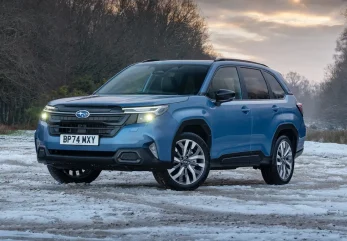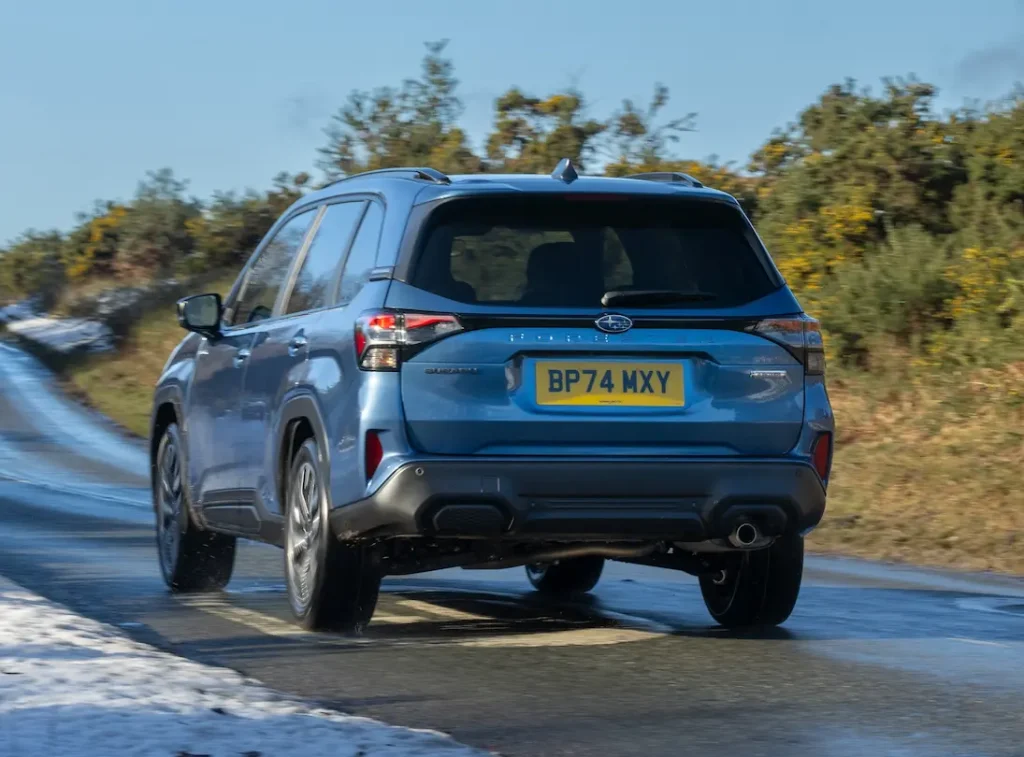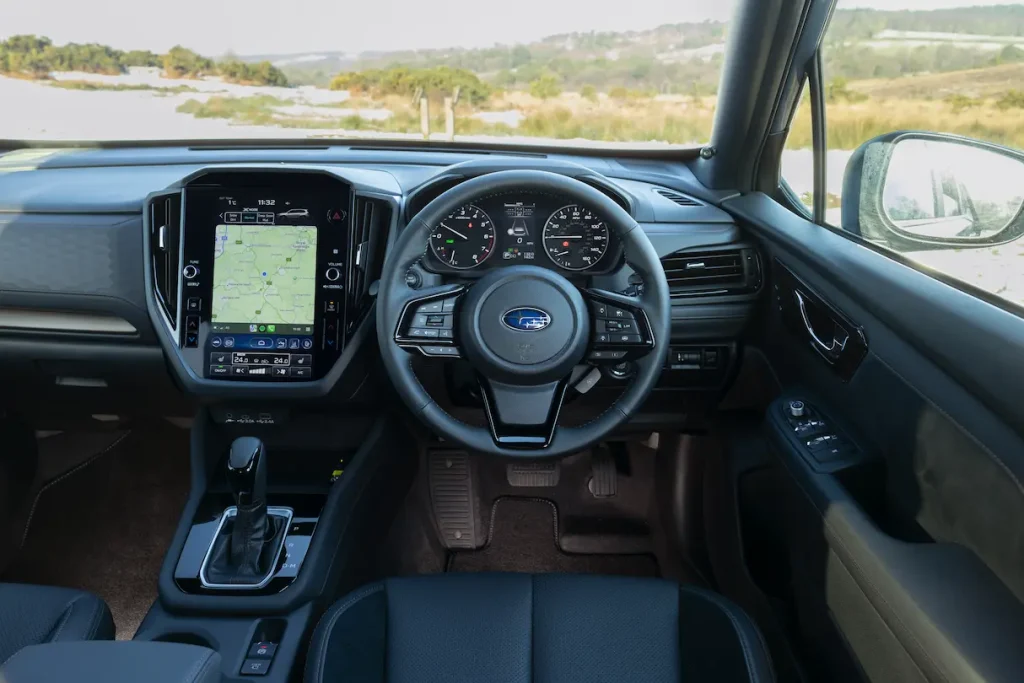
Although for many years most SUVs on the market have made at best token gestures towards the segment’s off-roader origins, Subaru still takes a more purist approach. Its Forester, entering its sixth generation with the new model tested here, is only available with four-wheel drive. In addition, Subaru is keen to highlight off-road focused features such as an enhanced X-Mode terrain selection system, and 220mm of ground clearance.
Performance and drive
Although we weren’t able to test the Forester off-road, during our drive in cold damp conditions we were still able to appreciate the benefits of four-wheel drive traction, giving us added confidence when pulling out of A-road junctions for instance. This extra traction also helps with cornering, and indeed we found the Forester to be a good drive for its segment, feeling more willing to change direction than expected, and benefiting from the sense of balance offered by some of the power going to the rear wheels. There’s a hint of body roll, but it’s not problematic.
There’s also a compliant quality to the ride, helped by fairly chunky tyres on the 18in wheels fitted with the mid-range Field equipment grade we’re concentrating on here – the 19s on the range-topping Touring grade (pictured) have a little more tendency to thud into potholes.

The new Forester has a single powertrain option. It features Subaru’s familiar boxer petrol engine set-up (which some may remember from past Impreza rally weapons) paired with a gearbox-mounted electric motor, creating a mild hybrid. The levels of power and torque on offer are fine around town, but the engine feels a bit more lethargic at higher speeds, having to be worked quite hard when joining a motorway or climbing B-road hills for instance. A subtle yet annoying whining sound is also sometimes noticeable, in particular when coasting to a stop.
On the subject of annoyance, we found the Forester’s driver monitoring system overly sensitive – you have to be quick with glances at the speedometer or sat-nav to avoid triggering it (we see how in principle this might be a good thing, but imagine in practice most will turn it off).
Interior and tech
The Forester’s no-nonsense off-roader roots are reflected in the interior trim – although some soft-touch materials are present, the general tendency is towards harder-wearing plastics. In some ways it puts us in mind of a high-end pick-up truck – which might sound harsher than intended – but it does feel more like an interior aimed at offering practical usage when out in the countryside, than the last word in luxury on the school run. The seats however are nicely trimmed and supportive, with a good range of electric adjustment including lumbar support.
All Foresters come with an 11.6in portrait infotainment touchscreen. This is well organised and responsive enough, and features useful climate control shortcuts at the bottom, but the fonts and graphics look a bit outdated, and something about the angle of the display made it prone to being obscured by reflections on our test drive.
Speaking of outdated, there’s no full digital driver display, just a TFT screen between old-school analogue instruments. Admittedly, by providing your speed and sat-nav instructions this screen does offer drivers the most vital information, but it still lags behind the vast majority of rivals in this class (and indeed most cars in lower segments) which offer digital clusters.

With Field spec, the rear seats offer impressive legroom and headroom – the latter is a bit compromised with the Touring grade by a sunroof, though only tall adults will be affected. Rear seat USB ports are also included.
The boot looks arguably bigger than the official 508-litre figure would suggest, possibly due to relative shallowness, but it benefits from a near-flat load lip.
In entry-level form, the Forester is among the cheapest four-wheel drive C-segment SUVs on the market – likely to be a selling point for Subaru’s traditional rural customers. However, with the mid-spec Field grade tested here, many four-wheel drive rivals are available for a minimal extra P11D figure, and generally also offer better fuel economy and CO2 emissions, with the Forester’s 183g/km figure for the latter placing it in the top 37% BIK tax bracket and also incurring a higher first-year VED payment. Therefore, given the Subaru also can’t match the best in this segment for interior quality or on-road refinement, we’d consider it unlikely to attract more than niche fleet interest.
Positive: Four-wheel drive traction, spacious interior, impressive seats
Negative: Engine lacks puff, outdated interior elements, high CO2 emissions
Standard equipment: 18in alloy wheels, automatic LED headlights, ten-way power adjustable and memory driver’s seat with lumbar support, eight-way power adjustable passenger seat, heated front seats, keyless entry and start, 11.6in infotainment touchscreen, wireless Apple Carplay and Android Auto connectivity, wireless phone charger, voice recognition system, adaptive cruise control, pre-collision braking, front and side alert assist, autonomous emergency braking, lane departure prevention, lane centre function, emergency lane keep assist, traffic sign recognition, intelligent speed limiter, blind spot monitoring, lane change assist, rear cross traffic alert, reverse automatic braking, driver monitoring system.
Engines: Petrol mild hybrid: 136hp 2.0
Equipment grades: Limited, Field, Touring
Transmissions: CVT automatic
| Model | Subaru Forester 2.0i e-Boxer Field |
| P11D | £39,300 |
| Residual value | TBC |
| Depreciation | TBC |
| Fuel | TBC |
| Service, maintenance and repair | TBC |
| Cost per mile | TBC |
| Fuel consumption | 34.8mpg |
| CO2 (BIK%) | 183g/km (37%) |
| BIK 20/40% a month | £242/£485 |
| Luggage capacity | 508 litres |
| Engine size/power | 1,995cc/136hp |
| Score | 6/10 |





